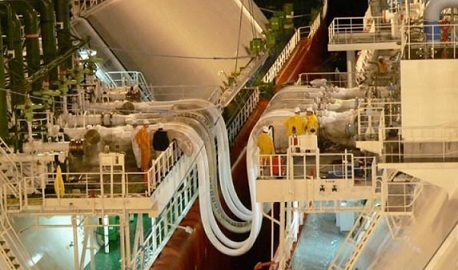

Home page|||
LNG handling |||
LPG handling||| Other Gas products|||
Fire & Safety|||
Emergency response |||
Minor or major leaks from LNG tanks & dealing with vapour clouds
An emergency can occur at any time and in any situation. Effective action is only possible if pre-planned and practical procedures have been developed and are frequently exercised.
The Contingency Plan provides guidelines and instructions that assist in making an efficient response to emergency situations onboard ships.
Major Leak from an LNG Tank- Not Ignited
If a major leak occurs and it can not be confined then jettisoning should be considered. Inerting of hold spaces shall be done same way as in case of minor leak.
i) Sound general alarm
ii) Stop cargo operation. Activate ESD
iii) Disconnect loading arms. PERC
iv) Leave jetty

LNG bunkering
v) As safety measure - Inert the hold space where leakage (Cargo Tank rupture) has been detected until the O2% is reduced to 2%. Continue blowing inert gas to hold space in order to keep temperature as high as possible. Remember to open the vent for hold space in order to avoid overpressure in the hold space
vi) Transfer cargo to other tanks in order to empty the tank.
vii) Consider - stability and stress factors.
viii) Consider - jettisoning. Remember two cargo pumps are required in order to have proper pressure in the nozzle.
ix) Consider - external assistance
x) Prepare fire fighting equipment
xi) Consider - abandonment. Prepare life-rafts, lifeboats
Minor Leaks from an LNG Tank- Not Ignited
If a small leak occurs the vessel will be able to handle the leak through the drip pan. The liquid will flow to the drip pan to be transferred by the eductor (by means of a spray pump), back to the tank. Driving liquid to the eductor is supplied by spray pump.
Data to remember: The tank designer advises that if a cargo tank cracks an average of 8 Liter/hour will be released. The Drip pan will be able to contain this kind of leakage for 15 days without transferring cargo to another cargo tank.
i) Release pressure in order to avoid further damages
ii) Isolate the rest of the hold spaces
iii) Transfer cargo to other tanks, if possible. Note that this is not normally possible on a normally loaded voyage as all tanks are full.
Vapour clouds
If there is no immediate ignition of an LNG spill, a vapour cloud may form. The
vapour cloud is long, thin, cigar shaped and, under certain meteorological
conditions, may travel a considerable distance before its concentration falls below
the lower flammable limit. This concentrate is important, for the cloud ignite and
burn, with the flame travelling back towards the originating pool.
The cold vapour
is denser that air and thus, at least initially, hugs the surface. Weather conditions
largely determine the cloud dilution rate, with a thermal inversion greatly
lengthening the distance travelled before the cloud becomes non-flammable.
The major danger from an LNG vapour cloud occurs when it is ignited. The heat
from such a fire is a major problem. A deflagration (simple burning) is probably fatal to those within the cloud and outside buildings but is not a major threat to
those beyond the cloud, though there will be burns from thermal radiations.
When loaded in the cargo tanks, the pressure of the vapour phase is maintained as
substantially constant, slightly above atmospheric pressure.
The external heat passing through the tank insulation generates convection currents
within the bulk cargo, heated LNG rises to the surface and boils.
The heat necessary for the vaporization comes from the LNG and long as the vapour
is continuously removed by maintaining the pressure as substantially constant, the
LNG remains at the boiling temperature
If the vapour pressure is reduced by removing more vapour than generated, the
LNG temperature will decrease. In order to make up the equilibrium pressure
corresponding to its temperature, the vaporization of LNG is accelerated, resulting in
an increase heat transfer from LNG to vapour.
Related Information:
- Leaks on the Cargo System, Continuous Flow - how to prevent
- Risk of Overfilling of Cargo Tank during Loading
- Leaks from a Loading Arm due to Tidal or Current Effects
- Compressed air system - Gas carrier immediate actions
- LNG tank leaks and immediate action by gas carriers
- Connection and disconnection of cargo hoses and hard arms
Risk of Overfilling of Cargo Tank during Loading
Cargo tank ruptures due to increased pressure - emergency procedure for gas carriers
Gas carrier Emergency Procedures for rescue

// Home page///
LNG handling ///
LPG handling///
Sea transport ///
Gas products///
Cargo work
///Fire precautions
///Health hazards
///Safety Precautions
///Emergency response ///

Copyright © Liquefied Gas Carrie.com All rights reserved.
The content published in this website are for general reference only. We have endeavoured to make the information
as accurate as possible but cannot take responsibility for any errors. For latest information please visit www.imo.org .
Any suggestions, please Contact us !
///Links &Resources //
Terms of use///
Privacy policy///Home page///


